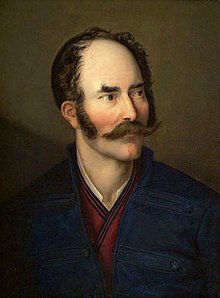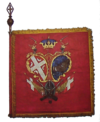Sima Milutinović Sarajlija
This article needs additional citations for verification. (September 2014) |
Sima Milutinović Sarajlija | |
|---|---|
 | |
| Born | Simeon Milutinović 3 October 1791 Sarajevo, Bosnia Eyalet, Ottoman Empire |
| Died | 30 December 1847 (aged 56) Belgrade, Principality of Serbia, Ottoman Empire |
| Pen name | Simeun Milutinov, Simeun Mil. Simović, Simša M. Sirotan, Simo Milutinović, Čubro Čojkovič, Čubro Čojković-Crnogorac, Srbo Srbović, S. M. Crnogorac, Si. M. Saraj. Černogo. Herak, S. M. Simović, Č.Č.Č. Exauditus |
| Occupation | Poet, hajduk, translator, historian, philologist, diplomat. |
| Nationality | Serbian |
| Literary movement | Romantism |
Simeon "Sima" Milutinović "Sarajlija" (Serbian Cyrillic: Сима Милутиновић "Сарајлија", pronounced [sǎːʋa milutǐːnɔʋit͡ɕ sarǎjlija]) (3 October 1791 – 30 December 1847) was a Bosnian Serb poet, hajduk, translator, historian, philologist, diplomat and adventurer.[1]
From his birth his life was a constant adventure. It began with his family's flight from the plague and the Turks. Its zenith came during the Serbian insurrections, and it ended in the unmatched glory of a poet and his grandiose political plans.
Life and work
Sima Milutinović was born in Sarajevo, Ottoman Empire in 1791, hence his nickname Sarajlija (The Sarajevan). His father was from the village of Rožanstvo near Užice, which he left running away from the plague and eventually settled in Sarajevo long enough to marry a famed town beauty Anđelija Srdanović who is Sima's mother.
Sima wasn't even two years of age when another plague outbreak hit Sarajevo. The family fled the town, seeking refuge on several locations in Bosnia, before going to Slavonski Brod, before ending up in Zemun where Sima commenced primary education but never completed it. He then attended school in Szeged (Hungary) and was later expelled from gymnasium in Sremski Karlovci.
During the First Serbian Uprising he was a scribe in Karađorđe's Governing Council (Praviteljstvujušći Sovjet). Sarajlija laid Dositej Obradović to rest and joined a guerilla band, commanded by hajduk Zeka Buljubaša. It was in the heat of battles with Ottoman Turks that his first poems germinated. They were not revolutionary odes, however, but love songs. They were inspired by his first great love - Fatima, a Turkish girl. After the collapse of the First Serbian Uprising he was a hajduk and teacher in Vidin. He also spent a year or two in a Turkish dungeon. After evading the Turks, he went to Chişinău (then part of Russia), where he remained, long enough to write The Serbian Maid. It is said that he sent reports to confidants of Miloš Obrenović I, Prince of Serbia concerning Karađorđe's followers in exile. This did not keep him later from turning against the Obrenović faction. In 1825 he went to Germany where he enrolled in the University of Leipzig, though he did not tarry there. Instead, a year later, he went back to Serbia to be a clerk in the employ of Prince Miloš but on arriving in Zemun, however, he turned about and went to Trieste, Kotor, and then Cetinje.
He arrived in Cetinje on 25 September 1827, uninvited, led by the passions of adventure and poetry and, at the same time, deep patriotism. He was neither the first nor the last stranger to be attracted by the blazing heroism and hidden power of Montenegro. A gifted adventurer—Stephen the Small—had once wandered into this land from out of nowhere, and organized the first civil government. There was something of the adventurer in the Petrović bishops as well—in every one of them, in one way or another. Sarajlija simply blew into the Montenegro wilderness, fleeing before the Kotor police because of the irregularity of his documents. He was to captivate Bishop Petar I Petrović Njegoš from the beginning. "As soon as I laid eyes on him, he came to my heart", the old man wrote to Jeremija Gagić, the Russian vice-consul at Dubrovnik, and added, "I do not know whether any other Serb would be willing to live in Montenegro." Sarajlija found Rade (the Bishop's nephew and the future Petar II Petrović Njegoš) there when he arrived.
The Bishop immediately took him in as a secretary. Sima pushed himself forward and grasped for power. He was not only sent, but he went himself among the tribes to dispense justice and settle disputes. He took upon himself the education of Bishop's nephew Rade. Then suddenly something came into his head and he disappeared into the mountains, shut himself up in a hut, and after several days returned with the tragedy Obilić.
He already had been everywhere, had experienced everything, had seen many different forms of government—including those born of revolution and arising from the most primitive conditions. He was nurtured in rebellions and prisons, in political strife, intrigue, and espionage, and, being himself unstable, unpredictable, he was accustomed to quick upheavals. Bishop Petar was to have many trials and tribulations with him. Sima got the old man to sign unread letters which brought the latter into conflict with Prince Miloš of Serbia. Miloš who recognized and had a regard for the genuine thing, was to pronounce a final judgement on Sima: A young cloud-chaster whose nose scrapes the sky.
As soon as he arrived, Sarajlija began to think up schemes, to have ideas, to lay plans. How would it be, he proposed an alliance to Prince Miloš to attack the Turks? He was in the very eye of the Montenegrin storm which lay pent up in the stillness of the monastery waiting to break out at the death of the old Bishop.
Direct and provocative, Sarajlija hardly felt like a stranger. Nor was he regarded as such. It was as though his irrepresible nature had found refuge for the first time, in a land in which—as he himself said -- every rifle is a cannon, every head anointed, every wish the general will, every home a castle, and every cliff a fortress.
He was a handsome man with a mighty frame, and this is not without importance in Montenegro. That is what his painting (the excellent portrait done by Katarina Ivanoviċ) also portrays—masculine beauty, willfulness, energy. He already enjoyed the fame of a poet, and his life was stormy even for those times of rebellions and revolutions. In 1829 Bjelice tribe struggled against Ozirinići and Cuce, two neighboring tribes, and Petar I Petrović-Njegoš sent Sarajlija and Mojsije to negotiate peace among them.[2]
Sarajlija remained in Cetinje more than three years—until the spring of 1831. But he still did not have enough of Montenegro. He was to come another three times—to be sure, on secret, inexplicable, and perhaps even invetented missions.
In 1836 he escorted Prince Miloš to Istanbul, only to find himself immediately thereafter in Prague, Vienna, and Budapest. He remained a while in Budapest and married there, in 1838, Marija Popović-Punktatorka (1810–1875), who was also a poet. (She carried on a lively correspondence with Vuk Karadžić, Milovan Vidaković, and Đorđe Marković Koder among many other men of letters, even before her marriage). In 1839 he was in Belgrade—deep in political intrigue. Again flight and wandering. In 1846 he led a group of Serbian students to St. Petersburg, where they were to study. He died suddenly in Belgrade at the end of 1847 at the height of his strength and vigor. He was mourned by all, as the greatest Serbian poet (of his day), even in distant Montenegro, where his erstwhile pupil, Njegoš, dedicated to his ashes an ode which was lavish and unstinting in love and appreciation. He was buried in the graveyard at St. Mark's Church.
Notable works
- Serbijanka, epic poem
- Nekolike pjesnice, stare, nove, prevedene i sočinjene Simom Milutinovićem Sarajlijom, book of poems
- Zorica, book of poems
- Tragedija Obilić, epic poem about Miloš Obilić
- Raspjevke Talfiji, book of poems
- Dika crnogorska, drama
- Istorija Crne Gore: History of Montenegro
- Pjevanija crnogorska i hercegovačka, collection of Serbian epic poetry from Montenegro and Herzegovina
- Tragedija vožda Karađorđa, epic poem about Leader Karađorđe
References
- ^ "Milutinović Sarajlija, Sima", Croatian Encyclopedia (in Croatian), Leksikografski zavod Miroslav Krleža, 1999–2009, retrieved April 24, 2014
- ^ Miloš Oben; Michel Aubin (1989). Njegoš i istorija u pesnikovom delu. Književne novine. p. 63. Retrieved 7 May 2013.
Бјелице су племе у Катунској нахији. Водили су 1829. оружану бор- бу са два суседна племена, Озринићима и Цуцама. Да би успоставио мир, Петар I је решио да им пошаље Симу Милутиновића и Мојсија
- Milovan Djilas: "Njegoš - poet, prince, bishop," Harcourt Brace (1966)
- Jovan Pejčić: Zasnovi Gligorija Vozarovića, 158 str, izd. Dental, Beograd 1995, ISBN 86-82491-08-7 v. fusnotu 166. na str. 118-120.
- Tanja Popović, Poslednje Sarajlijino delo - o Tragediji Vožda Karađorđa, Beograd, 1992.
- Jovan Skerlić, Istorija nove srpske književnosti (Belgrade, 1921), pages 156-163
- Adapted from Serbian Wikipedia: Сима Милутиновић Сарајлија

